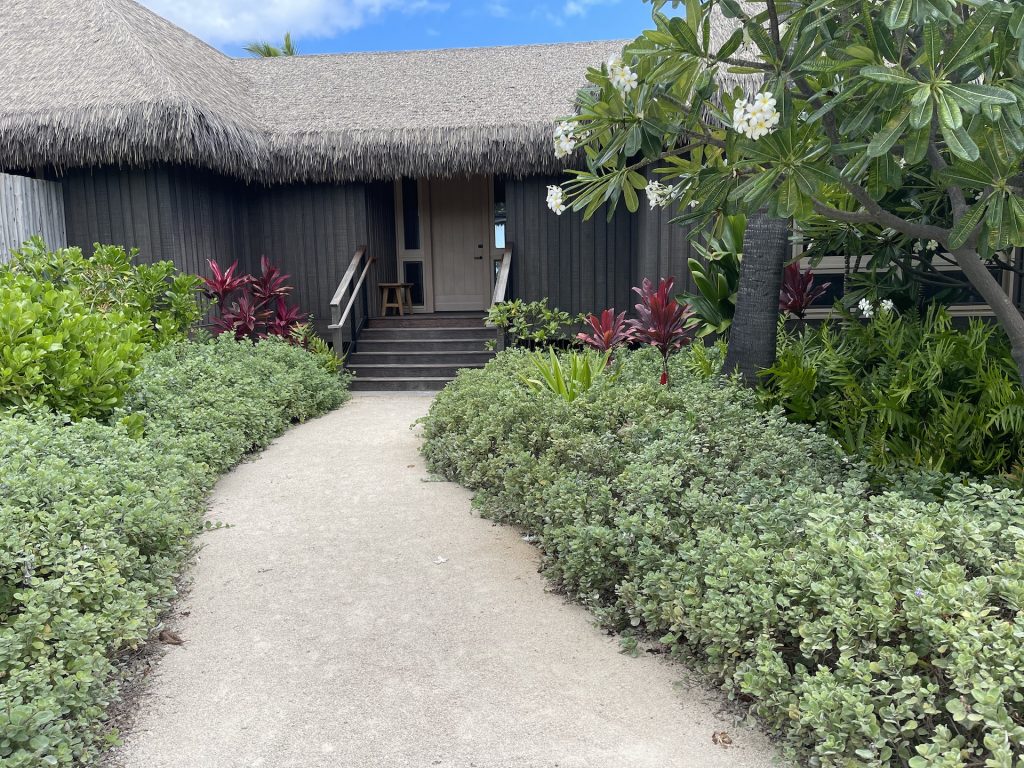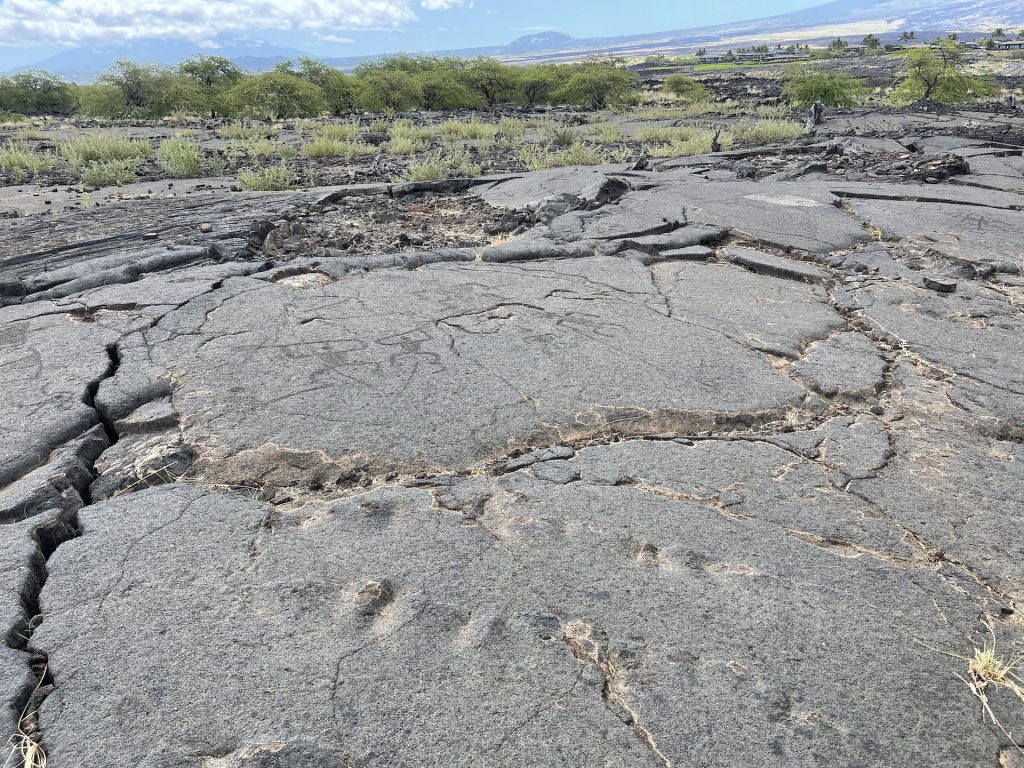Kona Village Resort reopens to its full glory 12 years after being destroyed by a tsunami

For first-time visitors, the drive to Kona Village Resort along Kona Coast’s Kahuwai Bay is exciting — and mysterious.
“What did I get myself into?” thought Bill Partmann, a guest in 2001.
He was shocked that part of the 10-mile drive north from Ellison Onizuka Kona International Airport to the resort was surrounded by black lava fields.
But the hardened remains of a Hualālai eruption made way for a Polynesian fantasy of green, swaying palms and cutesy little buildings.
“You still get that feeling today,” said Partmann, 72, of Sacramento, Calif.
But it took more than a decade to bring the resort back to its full glory after a March 2011 earthquake in Japan triggered a tsunami that steam-rolled Hawaiʻi. The huge waves caused catastrophic damage to the ocean-fronting hale (bungalows) and much of the property.
The beloved North Kona hideaway was shuttered in disrepair, and remained that way until 2017, when the Kennedy Wilson and Emerson Collective purchased it and started working on the renovation.
It was a major undertaking. But on July 1, Kona Village, now a Rosewood Resort, officially reopened.
Crushed coral pathways weave throughout the 81-acre property with 150 thatched-roof bungalows. Five are called legacy hale because their structures were rebuilt on foundations laid out when the resort originally opened in 1966.
Historical sites and petroglyphs were painstakingly preserved throughout the renovation of the resort. The southern end of the resort abuts Four Seasons Hualālai and stretches three-quarters of a mile north and about a third of a mile inland.
“As you walk around you don’t hear anyone, you don’t see anyone,” said Austin Watkins, the resort’s director of sales and marketing. “When you’re here you do lose a sense of time, but you’re in a place where it feels comfortable.”
Kona Village Resort is the second resort built on Hawai‘i Island. The first was Mauna Kea Beach Resort.
The bungalows were deconstructed using minimally invasive means and rebuilt with an emphasis on sustainable and ethically sourced materials. They are remodeled with the “finest” furniture and outfitted with local art and a fancy bar stocked with locally-made alcohol, they remain true to the original resort. No rooms have TVs.
“They are available if we need to provide them, but we have great WIFI and two days in guests are really enjoying it,” Watkins said.
The design was intentional with single-story buildings below the tree line. The landscaping looks lush but not perfectly manicured.
“A lot of this is a homage to what it really looked like,” Watkins said.
Each hale has a coconut, continuing the tradition of its use as the “Do Not Disturb” sign.
The hale range from one- to two-bedrooms. A king suite hale costs about $2,000 a night, and comes with an outdoor shower and deep basalt bath tub complete with a neck pillow.
There are four unique family suites that have a two-bedroom suite and two bedrooms. They function as their own compound, each with a pool, hot tub and fire pit. They also include a full kitchen, laundry and butler services.
Staff will pack and unpack, cook food and make activity arrangements. A family suite ranges from $14,000 to $22,000.
The bungalows are built in clusters with suites and rooms next to each other that open up into a shared grassy lawn. What’s happening, Watkins said, is travel agents or guests who know this book these rooms so they can have the space together.
“So many of these legacy guests are coming back to bring they grand kids who have never seen it or their kids who were tiny when they saw it and now they’re adults,” Watkins said.
There are two presidential suites on the north end of the property. One was occupied last week and another is at the tail-end of its renovation. A one-night stay in a presidential suite costs $40,000. That is not a typo.
Watkins said the presidential suite is a collection of four buildings including a living and dining area, swimming pool and elevated walkways to bedrooms. It’s about a 10,000-square-foot compound with butler services and all inclusive food and beverage experience.
The two presidential suites are different in that one is all-inclusive and the other has different pricing with regards to food and beverage. The presidential suites have an indoor and outdoor living room with direct access to a black sand beach.

“It’s a fair observation that some of our pricing is not affordable for island residents,” Watkins said. “Our best opportunity there is to make those kama’aina rates available and adjust them seasonally so we can offer an experience to the folks that would want to stay as well.”
While Kona Village is the iconic paradise escape, Partmann said what stuck out to him and his wife was the warm and enveloping environment of the staff, which over the years blossomed into friendships.
“That was the greatest attraction,” Partmann said. “They don’t just serve but they’re available on an honest basis. You’re there like your aunty is visiting you.”
From what Partmann can tell, that environment of fostering friendships between guests and employees has carried on with the reopening of Kona Village.
Partmann loved the place so much that not long after the tsunami hit, he started a Facebook page “Save Kona Village,” which now has 8,500 followers.
It started as a place where people could share their enthusiasm and support for the reopening of the resort. The group, along with Hualālai Homeowners Association, helped raise $250,000 for the employees who lost their jobs as a result of the natural disaster.
Partmann was able to connect with the new ownership in 2017 and started providing regular updates of the renovation’s progress to the Facebook page. He made regular visits out to the property where he would post pictures to social media.
“I watched the Phoenix rise,” Partmann said.
From rat-invested depleted buildings, Partmann said the new village took shape this past January.
“God, it’s beautiful. It’s like a gem that’s been buffed up. There’s something for everybody.”
Partmann was among the first to stay at the newly-renovated Kona Village. He and his wife flew over for the blessing and stayed for four days.
“It was incredible and emotional. You can appreciate the differences,” he said. “While everything is new there is a familiarity.
“The pools are magnificent. When you’re in the infinity pool and looking out to the Pacific, it’s seamless. There are little nooks and crannies you can escape to with little sitting areas where you can be alone and contemplate and enjoy the landscape and watch the world go by.”
Before anything had been touched, the new owners worked with the lineal descendants to form a six-person cultural advisory committee. They wanted to protect every archeological site, everything of cultural significance, even if the archeologists themselves didn’t find it.
The property encompasses many historical sites including the remains of a hōlua, or slide. The hōlua was used by ancient Hawaiians to slide down the mountain to the ocean.
There are several anchialiane ponds on the property that have ‘ōpae‘ula (red shrimp). The archeological remains of a school house remain protected, an anchialiane pond, known as the queen’s bath, is being preserved as well as dozens of petroglyphs in a lava field that dates back to after the 1801 lava flow from Hualālai.
There are approximately 150 petroglyphs with the largest array of Hawaiian sails etched into the rock. That’s how Kona Village got its original logo.
The resort also is focused on sustainability.
The fish pond is stocked with tilapia, which is an invasive species. The fish caught are sent to Ke Kai Ola Marine Mammal Center to feed the animals and they are also given to farmers for emulsion.
The resort has 8,000 solar panels. The thatching on the hale is made out of recycled plastic. The property has a water treatment plant where all potable water will be recycled. The resort provides bicycles for the guests and employees to get from place to place.
The village kept the tradition of the crushed coral pathways used by fishermen centuries ago to keep them visible at night.
Kona Village also has a place for a garden where they will plant several of the original plants brought over by Polynesian voyagers to Hawai‘i centuries ago.
“I think what makes this place so special is it was a thriving fishing village going back centuries,” Watkins said. “As we’ve worked with cultural advisors and lineal descendants the mo‘olelo they talk about dates back 2,000 years.”
Every employee has gone through cultural orientation. The resort leadership also has been trying to capture all of the teachings and stories from the cultural advisors about the property so it can be communicated to employees and the guests, and not be forgotten.
Sponsored Content
Comments




























